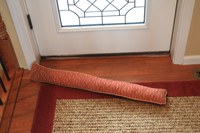Homeowners Have Simple Ways to Cut Heating Bills
(Click the image below to view a high-resolution image that can be downloaded)
With heating season under way, many people are looking for ways to reduce their heating bills.
“There are a few simple things you can do to save on heating costs,” says Carl Pedersen, energy educator with the North Dakota State University Extension Service. “Some of the easiest and least expensive are thermostat setbacks, sealing air leaks and using energy-saving window treatments.”
A thermostat setback is turning down the heat for certain periods of time. Generally, people turn the heat down at night, when they are sleeping, or during the day when they plan to be gone for several hours.
People may not use thermostat setbacks as a cost-saving method because of some misconceptions, according to Pedersen. For example, many people believe setbacks are not cost-effective because the heating system has to work harder to reheat the house to a comfortable temperature.
“This is simply not the case,” Pedersen says. “When the temperature falls below a set level, the system turns on to bring the temperature back above the set level. Once the temperature reaches the set level, it turns off. It is not like the throttle on your favorite automobile, where the harder you push, the harder the motor works. Heating systems are simply on or off.”
Many people also believe the furnace runs so long to reheat the house that this offsets any savings. Pedersen says the fuel used to reheat the house is roughly equal to the fuel savings while the home’s temperature was dropping to the setback level. The savings occur while the heating system is not using extra energy to heat at the lower temperature.
“The longer the thermostat is at the lower temperature, the greater the cost savings,” he adds.
According to the U.S. Department of Energy website at http://www.eere.energy.gov, you can save about 5 to 15 percent per year on your heating bill by turning your thermostat back 10 to 15 degrees for eight hours. That’s a savings of as much as 1 percent for each degree if the setback period is eight hours long.
Using a programmable thermostat allows homeowners to use setbacks without having to remember to adjust the temperature setting.
While thermostat setbacks will save money, keeping the heat in a home is key to reducing heating costs.
A properly built and insulated home will have minimal spaces for the conditioned air to leak out of the home. Energy-efficient builders attempt to seal all the air leaks and then control fresh air through mechanical ventilation that can exchange the stale air in a home but retain the majority of the heat.
Everyone can reduce the amount of heat that leaks out of a home by sealing leaks. Installing a fresh bead of caulk or weather stripping around doors and windows can be an easy fix for heat loss through air leaks, Pedersen says.
Another way to reduce air leaks is to install inexpensive heat-shrink film over windows to create a pocket of insulating air. The window films can be installed inside or outside the home to reduce the drafty feel caused by convective air currents in a home.
Adding window blinds or curtains also can reduce energy use. Any window covering can be used to reduce heat loss, but lined fabrics or honeycombed blinds generally are better insulators.
Opening blinds or curtains on the sunny side of the building will allow the sun to heat a home for free and reduce the need to spend money on lighting. Closing the blinds and curtains at nights helps retain the heat.
For more information on energy-related issues, check out NDSU’s energy Web page at http://www.NDSU.eduenergy.
NDSU Agriculture Communication - Nov. 8, 2011
| Source: | Carl Pedersen, (701) 231-5833, carl.pedersen@ndsu.edu |
|---|---|
| Editor: | Ellen Crawford, (701) 231-5391, ellen.crawford@ndsu.edu |


